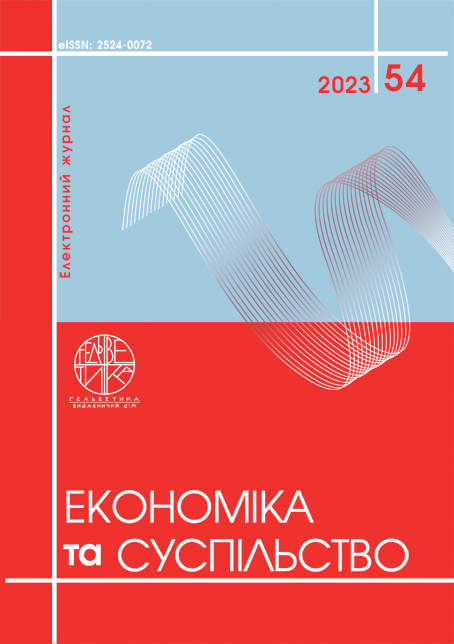ADAPTATION OF THE EU SINGLE MARKET TO THE DIGITAL ERA
Abstract
The article explores the transformation and adaptation of the EU Single Market in the digital era. Within the European Union, there is a strong emphasis on achieving convergence and integration in the digital sphere within a broader societal context. Furthermore, the COVID-19 pandemic has accelerated the digitalization of the economy as a response to mobility challenges stemming from pandemic-related restrictions. Consequently, there is an increased urgency for the European Union to swiftly and effectively adapt to the global process of digitalization. This adaptation becomes particularly vital when considering the alternative models of digitalization management that have gained prominence in the United States and China. The study analyzes how the European Union’s Single Market is transforming and adapting to the digital era. It has been observed that the EU strongly emphasizes fostering convergence and integration in the digital sphere within a broader societal context. Furthermore, it has become evident that adapting the European Union's Single Market to the digital age necessitates the removal of regulatory barriers and transitioning from national markets to a unified territory encompassing the entire EU. Notably, a significant challenge in the development of regional digital space regulation is the limited ability of member countries to effectively influence global digitization processes due to the absence of appropriate tools and mechanisms. The research findings emphasize the critical importance of aligning the European Union’s digital development with specific European requirements while avoiding alternative models designed for different purposes. The study’s conclusion underscores the European Union’s position as the undeniable leader in compatible digital public infrastructure. Despite this leadership, the EU remains committed to improving this infrastructure as part of its overarching initiative to complete the establishment of the Single Digital Market. Notably, the European Interoperability Framework is central to facilitating seamless communication and information sharing among public administrations across the EU. There are ongoing efforts to further enhance the effectiveness of this system.
References
Troitiño D. R. The European Union Facing the 21st Century: The Digital Revolution. TalTech Journal of European Studies. 2022, vol. 12, pp. 60¬78. DOI: 10.2478/bjes-2022-0003
Digital Services Act package // European Commission. URL: https://digital-strategy.ec.europa.eu/en/policies/digital-services-act-package (дата звернення: 18.08.2023)
Zayats O. The EU Global Competitive Force Index. Economic Annals-XXI. 2020, vol. 183, issue 5¬6, pp. 17¬25. DOI: https://doi.org/10.21003/ea.V183-02
Regulation (EU) 2022/1925 of the European Parliament and of the Council of 14 September 2022 on contestable and fair markets in the digital sector and amending Directives (EU) 2019/1937 and (EU) 2020/1828 (Digital Markets Act) (Text with EEA relevance) // EUR-Lex – European Union. URL: https://eur-lex.europa.eu/eli/reg/2022/1925 (дата звернення: 03.06.2023)
Digital Markets Act: ensuring fair and open digital markets // European Commision, 2023. URL: https://commission.europa.eu/strategy-and-policy/priorities-2019-2024/europe-fit-digital-age/digital-markets-act-ensuring-fair-and-open-digital-markets_en (дата звернення: 03.06.2023)
Zayats O. I. Trade and competitive cooperation of the EU with the major international integration groupings. Actual problems of international relations. 2020, vol. 143, pp. 55¬68. DOI:https://doi.org/10.17721/apmv.2020.143.1.57-68
Palinchak M., Zayats O., Bokoch V. The APEC integrated competitive force index. Baltic Journal of Economic Studies. 2020, vol. 6, Issue 4. September, pp. 118–124. DOI: https://doi.org/10.30525/2256-0742/2020-6-4-118-124
Troitiño D. (2022) The European Union Facing the 21st Century: The Digital Revolution. TalTech Journal of European Studies, vol. 12, pp. 60¬78. DOI: 10.2478/bjes-2022-0003
Digital Services Act package // European Commission. URL: https://digital-strategy.ec.europa.eu/en/policies/digital-services-act-package (accessed: 18.08.2023)
Zayats O. (2020) The EU Global Competitive Force Index. Economic Annals-XXI, vol. 183, issue 5¬6, pp. 17¬25. DOI: https://doi.org/10.21003/ea.V183-02
Regulation (EU) 2022/1925 of the European Parliament and of the Council of 14 September 2022 on contestable and fair markets in the digital sector and amending Directives (EU) 2019/1937 and (EU) 2020/1828 (Digital Markets Act) (Text with EEA relevance) // EUR-Lex – European Union. URL: https://eur-lex.europa.eu/eli/reg/2022/1925 (accessed: 03.06.2023)
Digital Markets Act: ensuring fair and open digital markets // European Commision, 2023. URL: https://commission.europa.eu/strategy-and-policy/priorities-2019-2024/europe-fit-digital-age/digital-markets-act-ensuring-fair-and-open-digital-markets_en (accessed: 03.06.2023)
Zaiats O. (2020) Mizhnarodna ekonomichna intehratsiia yak peredumova transformatsii hlobalnoi konkurentnoi syly. Sciences of Europe. (Praha, Czech Republic), vol. 4 (51), pp. 26¬30.
Palinchak M., Zayats O., Bokoch V. (2020) The APEC integrated competitive force index. Baltic Journal of Economic Studies, vol. 6, Issue 4. September, pp. 118–124. DOI: https://doi.org/10.30525/2256-0742/2020-6-4-118-124

This work is licensed under a Creative Commons Attribution 4.0 International License.


